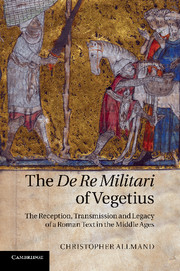 The De Re Militari of Vegetius
The De Re Militari of Vegetius from Part I - The medieval reception
Published online by Cambridge University Press: 07 October 2011
Consideration mainly of the manuscripts themselves, but also of information gleaned from wills and inventories, can reveal much about other texts with which the De re militari was closely associated in the Middle Ages, thus adding to our understanding of the way the work was regarded by its owners and readers. If the copying of a text is always deliberate, the accompanying text(s) given to it within a single codex, or ‘bed’, may not always be so. It can, none the less, often indicate how that text was regarded, and the (sometimes new) context within which its owners saw it. Although some 20 per cent of manuscripts are of the De re militari on its own, codices containing more than a single text can help us appreciate individual works through the eyes of the person who arranged them with particular bedfellows.
No surprise will be caused by the revelation that the text with which the De re militari is, by a very large margin, most frequently bound is the Strategemata of Julius Frontinus. Compiled in the first century AD, this comprised a collection of ‘exempla’ of military stratagems derived from both Greek and Roman historical sources, arranged under headings into four books, to support a work of military theory (also probably called De re militari) now lost. It cannot be determined whether Vegetius was familiar with this work, or depended on another for his knowledge of it. Frontinus is referred to twice in the De re militari, the relevant passages often bearing his name in the margins of manuscripts. The Strategemata proved to be a popular work in the Middle Ages; well over 100 manuscripts are known to have survived, including collections of excerpts and translations into at least three languages.
To save this book to your Kindle, first ensure no-reply@cambridge.org is added to your Approved Personal Document E-mail List under your Personal Document Settings on the Manage Your Content and Devices page of your Amazon account. Then enter the ‘name’ part of your Kindle email address below. Find out more about saving to your Kindle.
Note you can select to save to either the @free.kindle.com or @kindle.com variations. ‘@free.kindle.com’ emails are free but can only be saved to your device when it is connected to wi-fi. ‘@kindle.com’ emails can be delivered even when you are not connected to wi-fi, but note that service fees apply.
Find out more about the Kindle Personal Document Service.
To save content items to your account, please confirm that you agree to abide by our usage policies. If this is the first time you use this feature, you will be asked to authorise Cambridge Core to connect with your account. Find out more about saving content to Dropbox.
To save content items to your account, please confirm that you agree to abide by our usage policies. If this is the first time you use this feature, you will be asked to authorise Cambridge Core to connect with your account. Find out more about saving content to Google Drive.